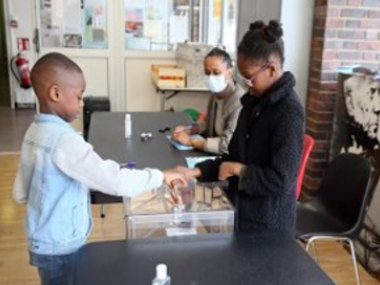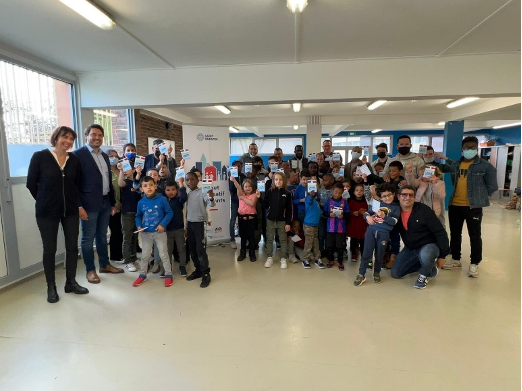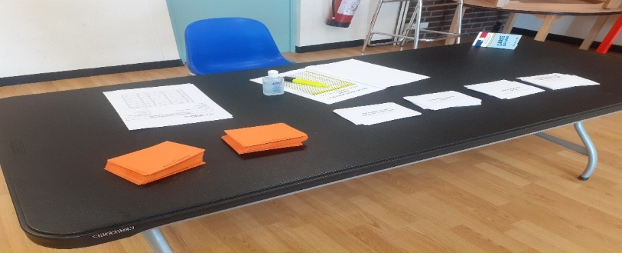PRESENTATION OF A SMALL SCALE ACTION: THE CHILDREN’S PARTICIPATORY BUDGET
Edited on
07 June 2022By Dominique PUCHAUX, Civil servant in charge of Active Citizen project
As part of the approach to the Active Citizen program and the issues to be addressed, the local group, composed of community residents, wanted to work on this question "How to develop citizen participation?"

Challenge: Co-deciding upon public budget participation
How to organize an experimental participatory budget among children with a budget of 5 000 €.
The aim is to work with young people who will be the adults of tomorrow. The earlier we make children aware of the issues, the more they will be involved in the life of the city in the future. They will master more the stakes of citizen participation.
Expected results
Disseminate citizen participation among children who are adults of tomorrow
Verify the process of setting up a participatory budget before its possible implementation at the city level.
Evaluation: The indicators:
- The number of projects implemented,
- the quality of the participatory project process
- Evaluation of the pedagogical process with the children and the partners
How was organized the SSA?
In close collaboration with the local group, the actors needed for this experiment were identified as well as the working methods to be adopted.
Three municipal social centers and after-school care centers of the nearby sectors were chosen. This represents approximately two hundred children aged 6 to 12 who attend these establishments.
Meetings between the local group, the educational teams and the organizers of the establishments were organized in order to explain the approach and give the instructions. The children had to propose projects of common interest for the neighborhood or the city. The organizers were responsible for raising awareness and helping the children.
A poster campaign and project deposits as well as the installation of ballot boxes to collect the children's ideas took place during the months of February and early March 2022.
On March 21, 2022, a project validation and feasibility study commission, composed of elected officials, technical services servants and site animators, met. It selected the following 4 projects:
- Creation of a reading space in an afterschool care center
- Creation of a shared garden in an afterschool care center
- Installation of benches around 2 city stadiums
- Development of the soccer field
The organization of the polling stations
 The children therefore voted on Wednesday, April 27 in the social centers and after-school care centers. “We wanted this vote to take place under the same conditions as a real election to encourage these young people to exercise their citizenship. We have therefore:
The children therefore voted on Wednesday, April 27 in the social centers and after-school care centers. “We wanted this vote to take place under the same conditions as a real election to encourage these young people to exercise their citizenship. We have therefore:
- Provided the children with a voter's card.
- Set up voting booths and a ballot box.
- Provided them with a voting sheet.”
The children counted the results themselves with cards and tables with four tellers were formed.
Partial conclusion of this challenge.
 The children were surprised that they could be asked for their opinions. They understood the instructions relatively well. Indeed, 123 proposals came out of the ballot boxes, 66 of which were usable for our experiment.
The children were surprised that they could be asked for their opinions. They understood the instructions relatively well. Indeed, 123 proposals came out of the ballot boxes, 66 of which were usable for our experiment.
The other ideas were related to the current events and the conflict in Ukraine "stop the wars" help poor people. But also around ecological issues "save the planet".
The professionals and the children were delighted and happy to know that their projects were selected and went to the vote. On the day of the vote, we had a 100% participation rate, so two hundred children were able to express their choice.
The results were announced on May 4, 2022, at the Saint Quentin City Hall, in the presence of the Mayor. On this occasion, the children received a diploma of citizen participation.
This experiment demonstrates that a participatory budget on a larger scale is possible. It seems that the budget should be distributed by neighborhood to encourage participation and avoid reinforcing the social inequalities present in the territory. Indeed, it is the highest socio-professional categories that are likely to take advantage of this type of system to the detriment of residents in so-called difficult neighborhoods. This distribution of the envelope would also allow for development within each neighborhood.
It also showed that children had difficulty going beyond the neighborhood dimension in their thoughts and requests. Our ambition to make young people aware of the life of the city and to reinforce citizen participation within our territory via a participatory budget was completely justified.

Unintended effect:
“At the beginning of the experimentation, we had not anticipated that this would be the occasion to make such an exercise of citizenship around the vote in conditions as close as possible to reality”.
Submitted by Barbara Gautherie on
